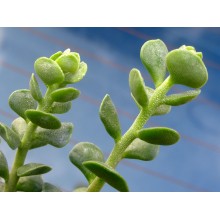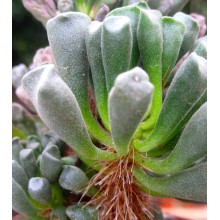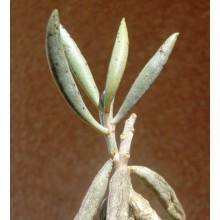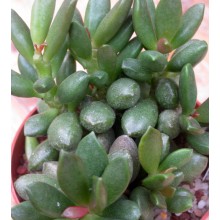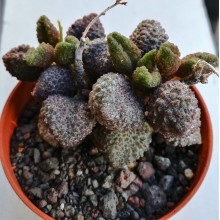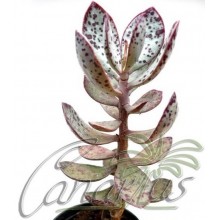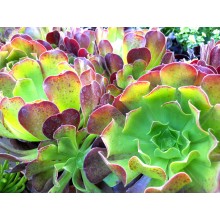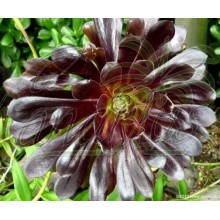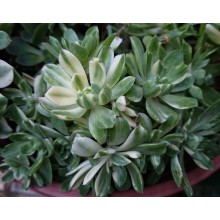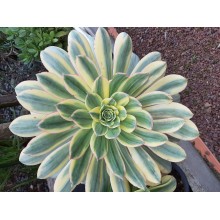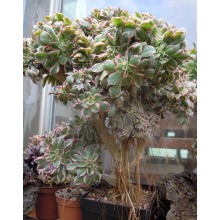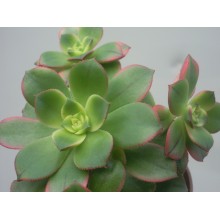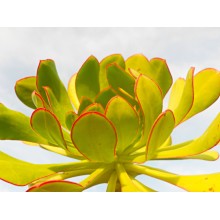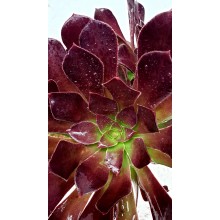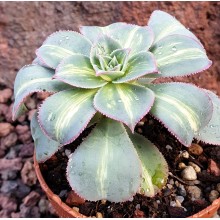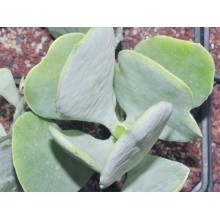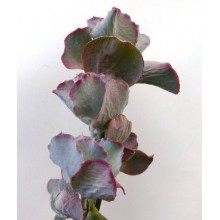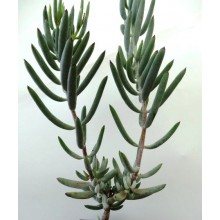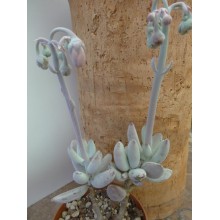Crassulaceae Il y a 130 produits.

Cette nouvelle et croissante section des espèces de la famille des Crassulaceae. Il ya environ 1400 espèces dans 33 genres et leur ditribution est dans le monde entier, mais se produisent surtout dans le hémisphère Nord et en Afrique australe, en particulier dans les milieux secs. Ici vous pouvez acheter des plantes saines et durcie par le soleil, cultivées dans les îles Canaries et expédiés à votre domicile.
-
Adromischus caryophyllaceus CG62 Robertson
Adromischus caryophyllaceus CG62 Robertson
Beautiful Adromischus with erect branches and round-spathulate leaves, coated with a blueish-grey wax. It bears in summer relatively large flowers with purple mid-stripes.This clone was collected in Robertson, in the Western Cape and recorded as CG62.
10,20 € -
Adromischus cooperi
Adromischus cooperi
Large, branched, cont.= 8,5 cm - A slow growing South African species with swollen purple leaves, with grey-purple blotches, and undulating leaf apex. It will enjoy some light shade in the hottest months.
12,20 € -
Adromischus cristatus var. clavifolius
Adromischus cristatus var. clavifolius
Large, Branched Plant - Easy but slow South African succulent with "hairy" stems. These hairs are showy reddish-brown aerial roots. This clone has spathulate leaves with apical margin undulate.
10,20 € -
Adromischus filicaulis ssp. filicaulis
Adromischus filicaulis ssp. filicaulis
This Adromischus has long grey leaves, more or less spotted, on erect stems. It is another variable species of this interesting genus.
10,20 € -
Adromischus mamillaris
Adromischus mamillaris
This is a low-growing Adromischus, densely branching, with grey-green pointed leaves, only mildly mottled. This South African species has the widest geographical distribution in the genus.
10,20 € -
Adromischus marianae v. herrei
Adromischus marianae v. herrei
Weird beauty from the South African desert. It is a must for collectors of Crassulaceae or extreme succulent plants. This Adromischus has short dark leaves with an incredibly rough surface which is a masterpiece of nature. It changes colours through the seasons from green to brown, red or more.
12,30 € -
Adromischus triflorus
Adromischus triflorus
Pot = 8,5 cm. Variable species native to South Africa. It forms clusters with thick, silvery green leaves. This form has ovate-pointed leaves with abundant reddish speckles, tending to become more intense in bright light.
12,20 € -
Aeonium arboreum cv. Purpureum
Aeonium arboreum cv. Purpureum
A garden selection with leaves stained with purple tips and spots.
10,20 € -
Aeonium arboreum cv. Zwartkop
Aeonium arboreum cv. Zwartkop
h= 10 cm - Cont.= 8,5 cm. The black aeonium is an old classic cultivar. Rosettes have burgundy-black leaves and the bright yellow inflorescence make a showy contrast.
11,80 € -
Aeonium castello-paivae cv. Suncup
Aeonium castello-paivae cv. Suncup
A beautiful variegated selection, well-striped in different tones of jade. It is one of the smallest species of Aeonium but it branches with multiple offsets. It is a tender soft succulent, and will not tolerate frost.
11,20 € -
Aeonium cv. Sunburst
Aeonium cv. Sunburst
Robust, rooted, unbranched plant. An incredible rainbow of colour! This aeonium is the boldest of all. Each leaf has a painting of dark green, jade, white and pink.
10,20 € -
Aeonium decorum f. cristata variegata
Aeonium decorum f. cristata variegata
Variegated AND crested. This plant is truly unusual and will slowly become a bonsai-like tree structure. The natural form of this species is originally native to the Canary Islands.
10,20 € -
Aeonium decorum tricolor 'Kiwi'
Aeonium decorum tricolor 'Kiwi'
Colourful selection of a branched Aeonium, with "rainbow" rosettes. Easy growing, it is probably a clone of the widespread A. decorum, native to the island of La Gomera, in the Canary Islands.
10,20 € -
Aeonium urbicum
Aeonium urbicum
Beautiful succulent plant endemic to Tenerife. This species of Aeonium does not branch, it grows upright and it bears a huge piramidal inflorescence. "Urbicum" means "urban", because it is often seen growing among tiles on the roofs of the city of La Laguna, in an "urban environment".
10,20 € -
Aeonium x 'Blushing Beauty'
Aeonium x 'Blushing Beauty'
Colourful classic hybrid, germinated in 1976 in Southern California by Jack Catlin, who crossed Aeonium canariense with Aeonium arboreum 'Zwartkop'.
10,20 € -
Aeonium x 'Lemon and Lime'
Aeonium x 'Lemon and Lime'
h= 10 cm - Cont.= 8,5 cm. It is a spectacular American hybrid of Aeonium decorum. It is characterised by the yellow band along the centre of its leaf. It ends with pink serrated edges. The rosette can be up to 30 cm wide.
15,30 € -
Cotyledon orbiculata cv. Rose
Cotyledon orbiculata cv. Rose
NEW ! - Cotyledon orbiculata 'Rose', is a cultivated clone with especially wavy leaves, with rose-coloured margins. A real beauty, hardy to about - 6 C.
10,30 € -
Cotyledon orbiculata var. flanaganii
Cotyledon orbiculata var. flanaganii
Beautiful and easy to grow crassula with blue-green leaves with red tips and showy orange flowers.
10,20 €
Pour le moment, il ya peu de produits dans cette catégorie Crassulaceae
















